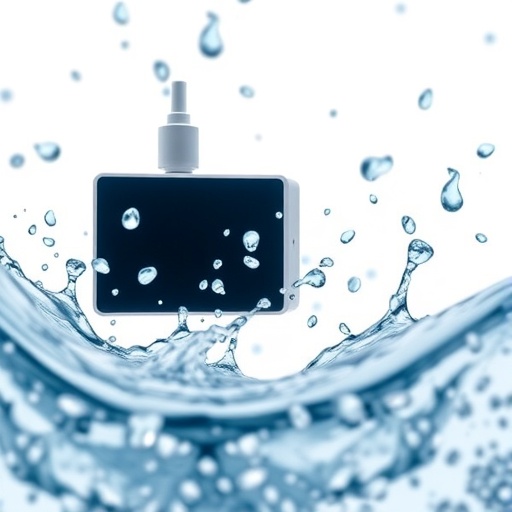In recent years, environmental concerns have escalated, revealing the urgent need to combat water pollution, particularly contamination from pharmaceuticals such as antibiotics. Despite their invaluable role in medicine, antibiotics pose a significant environmental risk when they infiltrate aquatic ecosystems. As bacteria develop resistance to these drugs, the effectiveness of antibiotics diminishes, outlining a crucial need for effective removal technologies. Among various remediation methods, a newly proposed technology, supercritical water oxidation (SCWO), shines as a beacon of hope in addressing this pressing issue.
Research led by Dias, Mourão, and de Souza focuses on the potential of supercritical water technology as a solution for the degradation of antibiotics in water environments. The study’s findings suggest that this innovative method could efficiently eliminate pharmaceutical contaminants while offering a sustainable alternative to conventional wastewater treatment processes. Recognizing the dangers posed by antibiotic pollution, the researchers emphasize the pressing need for technologies capable of breaking down these hazardous substances effectively.
Supercritical water is a state of water attained at high temperatures and pressures, where it exhibits unique solvent properties. In this supercritical phase, water behaves differently than in its liquid or vapor forms, allowing for enhanced chemical reactions. The researchers explain that this state enables water to dissolve various organic compounds, making it a powerful medium for the degradation of complex pollutants, such as antibiotics. The ability to operate under high-pressure conditions increases the reaction rates and improves the decomposition of these harmful substances, ensuring a higher degree of mineralization and reduced toxicity.
In the study, the authors evaluated the efficacy of SCWO using various antibiotics, analyzing parameters such as temperature, pressure, and reaction time. Their results demonstrated that increasing the operational temperature significantly enhances the degradation of antibiotic compounds. Furthermore, the research indicates that specific antibiotics exhibit varied resistance to degradation in supercritical water, necessitating tailored approaches for different pollutants. This finding opens the door for further research aimed at optimizing conditions to maximize the breakdown of resistant compounds.
Supercritical water technology operates efficiently under the right conditions and can be integrated into existing wastewater treatment infrastructures. This adaptability is crucial for municipalities struggling with antibiotic contamination, as implementing SCWO could significantly enhance current treatment processes. As antibiotic resistance continues to rise, the ability of SCWO to neutralize a diverse range of compounds while minimizing environmental impact presents a compelling argument for its widespread adoption.
One of the most remarkable aspects of SCWO technology is its potential to convert waste into energy. The process can yield useful energy outputs, such as heat and gas, through the degradation of organic materials in contaminated water. By utilizing the energy produced during treatment, facilities can reduce operational costs, promote sustainability, and make significant strides toward energy neutrality. This dual benefit emphasizes the integral role of SCWO in the broader framework of environmental remediation and sustainable practices.
The implications of the research extend beyond mere technical advancements; they touch upon urgent societal issues such as public health. The accumulation of antibiotics in water sources not only threatens aquatic creatures but poses risks to human health as well. As resistant bacteria proliferate, they compromise the efficacy of lifesaving treatments. The researchers urge governments and regulatory bodies to consider implementing supercritical water technology in the fight against pharmaceutical pollution.
Public awareness of antibiotic pollution is also a crucial element in the success of remediation efforts. Educating communities about the significance of proper medication disposal and the risks associated with contaminating water sources may help reduce the load on treatment facilities. Combined with innovative technologies such as SCWO, these educational initiatives could play a significant role in curbing the environmental impacts of antibiotic use in medical practices.
Looking ahead, the study’s authors acknowledge the need for further research to refine and optimize supercritical water technology for practical applications. They suggest that long-term studies addressing various operational parameters and their effects on antibiotic degradation should be prioritized. Such research would not only solidify the role of SCWO in wastewater treatment but also reinforce its position as a game-changing technology in environmental protection.
Furthermore, collaboration between academia, industry, and regulatory bodies will be essential for advancing supercritical water technology. Developing pilot projects and scaling these innovations will require investment and commitment from a myriad of stakeholders. The authors stress that fostering partnerships can expedite the transition from theoretical applications to mainstream practices, paving the way for more effective solutions to combat antibiotic pollution.
In conclusion, Dias, Mourão, and de Souza’s research shines a light on the transformative potential of supercritical water technology in addressing antibiotic contamination in aquatic environments. By promoting efficient and sustainable practices, this technology represents a valuable addition to the toolkit of environmental scientists and policymakers. As the ramifications of antibiotic pollution become increasingly critical, embracing innovative solutions like SCWO may well be a vital step toward preserving public health and safeguarding our ecosystems.
The fight against antibiotic resistance is not merely a scientific endeavor; it is a call to action for all sectors of society. Together, we must strive to implement technologies that address these challenges, fostering a healthier planet for future generations. The study highlights the pressing need for innovative solutions in environmental engineering and continues the discourse on improving public health through responsible antibiotic use and pollution prevention.
In an era where environmental degradation threatens both human health and ecosystems alike, the insights gained from this cutting-edge research pave the way for a more sustainable future. As we look toward implementing effective wastewater treatments, supercritical water technology emerges as a paramount tool in our ongoing battle against pollution and antibiotic resistance.
Subject of Research: Supercritical water technology for degradation of antibiotics in water.
Article Title: Supercritical water technology: a promising approach for degradation of antibiotics in water.
Article References:
Dias, I.M., Mourão, L.C., de Souza, G.B.M. et al. Supercritical water technology: a promising approach for degradation of antibiotics in water.
Environ Sci Pollut Res (2025). https://doi.org/10.1007/s11356-025-37107-7
Image Credits: AI Generated
DOI: https://doi.org/10.1007/s11356-025-37107-7
Keywords: Supercritical water technology, antibiotic degradation, environmental remediation, wastewater treatment, public health.




